Knowing how to preserve your harvest even without refrigeration is an important way to deal with surpluses and avoid waste, as well as to see you through months when your garden isn’t as plentiful.
The first step to successful longer-term preservation is understanding what makes produce spoil in the first place. When it comes to food storage, your biggest enemies are:
- Some foods begin to dry out when exposed to oxygen for prolonged periods. You may notice changes such as lettuce becoming limp and wilted, oranges shrinking and hardening, or the skin of cucumbers starting to wrinkle.
- Humidity is often a good thing when it comes to fruits and veggies, but too much moisture can lead to quicker rotting. That’s why, for example, greens stay fresh so much longer when stored with paper towels between the leaves.
- Ethylene gas. A natural plant hormone, ethylene gas speeds up ripening when exposed to oxygen and carbon dioxide. Some veggies and fruits release this gas as they age. The release of ethylene gas affect other nearby produce, so foods that produce ethylene should be kept away from foods that are sensitive to it.
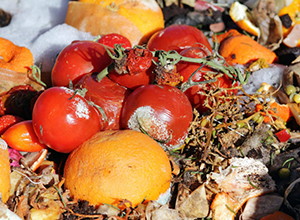 Produce tends to be rich in natural enzymes that provide essential health benefits for our bodies. These enzymes become active when the food is cut or peeled. They are also sensitive to heat and will cause the food to spoil quickly once cut.
Produce tends to be rich in natural enzymes that provide essential health benefits for our bodies. These enzymes become active when the food is cut or peeled. They are also sensitive to heat and will cause the food to spoil quickly once cut.- Other chemical changes. Oxygen, sun exposure, and high temperatures all work together to escalate the spoilage of your produce. In general, store your food away from heat and sunlight, and eat any pieces with natural cuts or bruises first.
Do keep in mind that any mishandled produce may contain unsafe microorganisms that can cause illness if ingested. Any pathogens in your fresh food can quickly multiply at room temperature, make your food spoil faster, and potentially spread to other foods nearby. Do not eat anything that you suspect may be contaminated or rotten.
With this information in mind, let’s look at the best ways to preserve your whole harvest with no refrigeration.
Related: Sealed Foods that Last Forever
Storing
Some of your fruits and vegetable will store well for months under the right conditions.
For best results, choose unblemished items and check them regularly for signs of spoilage – it’s true that “one rotten apple can spoil the whole bunch.” Here are some tips for storing different items.
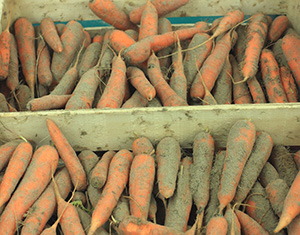 Root Vegetables
Root Vegetables
Potatoes, carrots, and beets are well-suited to storing.
Remove the leafy tops from carrots and beets and place them in a single layer without wrapping. A layer of sand can keep both from becoming rubbery.
For potatoes, harvest them on a dry day and leave them out in the sun to dry completely. Remove any mud and store in paper sacks in the dark.
Parsnips are a root vegetable exception: leave them in the ground over winter and harvest as needed.
Apples and Pears
These fruits will also store very well. Wrap each fruit in newspaper and store in a single layer.
Garlic, Onions, and Shallots
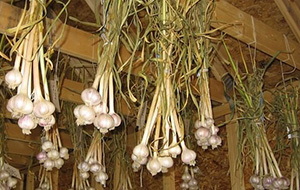 Dry these veggies thoroughly and then braid before storing in a dry place.
Dry these veggies thoroughly and then braid before storing in a dry place.
Alternatively, you can cut off the tops and fill a net or an old pair of stockings with the bulbs.
Hang these to keep them dry, preferably in a breezy location.
Related: Homemade Fermented Honey Garlic
Items in The Squash Family
Pumpkin, butternut, and spaghetti squash, for example, can last for several months, depending on the type.
Pumpkins won’t likely last past midwinter, but other squashes may keep well through early spring. Choose specimens in good condition and store them in a cool, dry place. Zucchini does not store well, unfortunately.
Beans and Peas
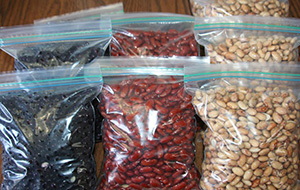 You can dry beans and peas for long-term storage.
You can dry beans and peas for long-term storage.
There are different methods for drying beans at home – one method is to simply leave the pods on the plant until they are dry and hard and will break and spill the seeds out (but be sure to harvest before they break on their own).
Keep dried beans around to use in soups, stews, or as meals all on their own.
Leafy Greens
Leafy crops, such as spinach and lettuce, do not store well long-term. However, you can continue sowing these plants into early autumn so that there will still be fresh leaves to harvest after the weather turns colder.
Drying
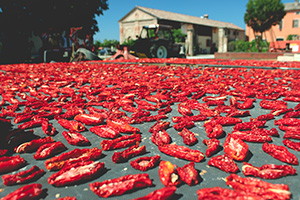 You can dry some foods to produce interesting new flavors and textures to add to your dishes when you cook.
You can dry some foods to produce interesting new flavors and textures to add to your dishes when you cook.
Tomatoes, apples, and peppers all dry well. Drying produce is easy; simply slice the food thinly and arrange in a single layer on a tray. You can then use the traditional method, which involves leaving your trays outside over long, sunny days.
Alternatively, you can use a quicker and easier process: set the trays in your oven on its lowest setting (250F) for a few hours or until the food has shrunk and become almost crispy. Then, store the dried pieces in sterile, airtight containers and use them within several weeks.
Pickling and Canning
Beets and shallots taste delicious when pickled and will last for months.
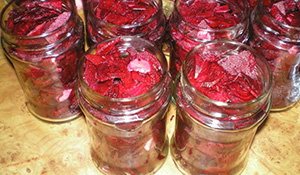 Beets
Beets
Wash and prepare your beets but avoid removing the tops too close to the root, as this may allow the color to leach out.
Boil for half an hour or until the tops and skin rub off easily. Slice the beets, place in sterile jars, and cover in pickling vinegar.
Shallots
Peel and trim the bottoms and tops. Let sit overnight in a shallow dish filled with salt to draw out excess moisture. The next day, rinse the shallots thoroughly, place in sterile jars, and cover with pickling vinegar.
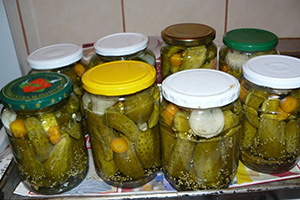
Good news for zucchini lovers: you may not be able to store them dry for very long, but you can make chutney with them, as well as more or less any excess from your garden, such as tomatoes, plums, garlic, mint, onions, cherries, and much more.
Related: Canning Meatloaf for Meals in a Jar
You may also can a wide variety of vegetables and fruits for later use, including cucumbers, tomatoes, beans, corn, most fruits, squash, leafy greens, asparagus, carrots, and more.
If you own chickens or cows, you may also bottle stock.
You worked hard on the food you grew; a little know-how can help you keep it fresh and healthy well into the winter months. Congratulations on your great harvest!
You may also like:
How to Make A Self-Sufficient Backyard on 1/4 of an Acre (Video)
If You See This Berry, You May Want To Harvest It
How to Adjust the pH in Soil and Water for Abundant Harvests

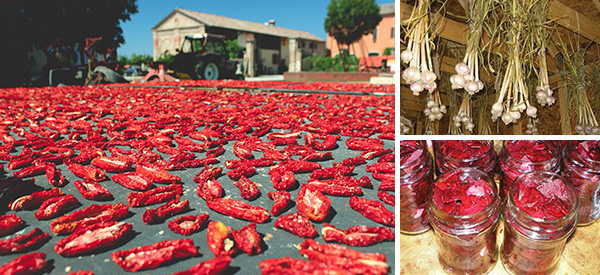
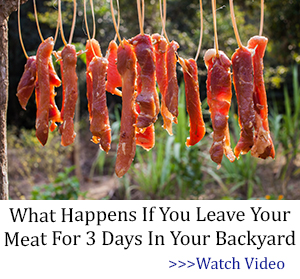




















If drying foods outside I would have them covered with a second screen side a cabinet type framework to keep flies and other insects from setting on them.
Marilyn: No greater joy than having to deal with hordes of wasps trying to seal drying fruit. Add a long box topped with sheet steel for a solar collector. Even here, Arizona, it works a lot better. Metal, not glass because glas has been known to cause fires. niio
When I dry our persimmons I use those pop-up picnic tents to cover the fruit to keep flying pesties from alighting on same. They fit nicely over the cookie cooling racks I have the fruit on. The only drawback is that I have to make sure to tie them down with twist ties if it is windy, otherwise they have a tendency to fly away. Foled up they store nicely in a heavy shipping tube I got with something else inside long ago.
From the personal accounts I’ve read the only vegetable homesteaders on the Texas frontier preserved was flint corn, which could just be dried on the stalk and thrown into a bin. Antebellum travelers in Texas encountered no inns outside of the few towns, the homesteaders, poor or less poor or the few well off, offered travelers food and shelter for free. For the most part travelers report that the entire state, outside of the small area of German settlement, lived off corn mush and pork or corn bread and pork, and no one bothered to make butter for the danged corn bread. Hot weather here makes preserving a challenge, pressure canning or pickling are the only good method for saving vegetables. I’ve been wondering how to preserve meat in a 19th century Southern climate, here’s a good article I found, hint, you need a big stock of preservatives!
http://www.texasescapes.com/CFEckhardt/Preserving-Meat-on-the-Frontier.htm
An interesting read, Mike. I understand butter was packed in sawdust for the trip from England to India or Hong Kong in the days of sailing vessels and later steamers before refrigeration. Salted butter preserved better than unsalted. Even today salted butter is purported to last longer than unsalted. I don’t know the time span for “longer”.
LCC: clarify it or soften and add yogurt to make ‘aged’ butter. Yogurt helps by acidifying the butter, but it still needs to used asap, but lasts longer. This is the butter shipped to Europe in barrels packed with passenger pigeons, pork, turkey, and so on.
Dry age beef used to be easy, till they reinvented it. Old-timers hung a side of beef in a shady place, covered well with old sheets, and took what they wanted. People here have been doing that for thousands of years.
Poultry was brined, not hung (a la European ptomaine palace). Partly cooked, it could be stored in butter or grease. niio
Clarified butter or Indian Gee has a pretty good shelf life without refrigeration. I use to make it when butter was on sale. Now you can find it prepared in the supermarket here on the regular shelf with a two year best by date.
CC: ! Butter stays in the freezer up to 6 months. After that, if not used it should be turned into ghee or mixed with a little yogurt, which acidifies it. Ghee is the best bet. niio
Adding to the article:
Garlic, Onions, and Shallots
Need to be stored in paper bags or they dry out. Light is the worse thing for them.
Squash: winter squash can be stored up to a year in a cool, dry place. Some types like 7 year melon will store for up to 7 years, only growing sweeter as they age.
Any grain, including peas and beans, should be frozen for a week or two to kill weevils. Diatomaceous earth kills any insects that attack it later.
Most root crops do best in soil or sand. It prevents sprouting and keeps them from drying out. All root crops need to be stored out of light to prevent drying out or sprouting.
Old-timers used to store only apples bred for storage. Red Delicious will store for a year. Most varieties store for a few weeks or months. To store, they hung apples by the stem an inch apart in a cool, damp place. One variety stored so well in a smokehouse, it got it’s name for that. Most pears were not bred for storage, but should be processed ASAP. Dry them or keep in newspaper for a month at best. If canning waterbath, add a teaspoon of lemon juice per quart to bland apples. Pears should be canned in a pressure canner. niio
For something interesting and a potential disaster,
https://www.youtube.com/watch?v=PyMkD6pUWlg&t=235s
Red: Food for Patriots and Power for Patriots is Wise Foods or the other way round, I am not sure which is the parent company.
They sell packages of food. They were one of the ones I complained about a year or two ago as misrepresenting their emergency food supplies. They advertised them as so many days worth when, in fact, they were no where near that many days worth. I actually got a reply back from someone connected with the company and his reply was that their food wasn’t meant to be your complete food supply but was just a supplement, that you should supplement their “meals” with vegetables, bread, milk, dessert etc.
They have now changed their advertising. They now advertise so many servings. That tends to lead the unwary, in my opinion, as to how long the food will last one person. They advertise 335 “servings” but the servings are from 235 calories to 350 calories. The FDA advertises that the average caloric intake for the US is 2,000 calories. So the supply will last one adult 58 days, not the 100 days that the unwary thinks the package will last.
Your activity level, age and sex play important roles in how many calories you need per day.
In addition, Wise Foods or Food for Patriots is very scant in protein. It is loaded with carbohydrates, Which in and of itself isn’t bad, but lack of protein will cause a reduction in muscle mass and in a situation where you need 30 or more days of emergency rations, you probably are not sitting in front of your iPad playing video games or watching movies.
I suspect the two solar panels he shows in this video will require about two weeks to recharge the power pack to full capacity from a zero state. I haven’t studied solar power enough to make definitive statements about it, but generating enough juice to run your household, not counting TV or other entertainment devices, just refrigerator, freezer and perhaps the fan for your heater takes a lot of generating power. It takes a lot more power to run a whole house a/c unit.
Those two panels he is showing will probably generate enough juice to charge cell phones, iPads and laptop computer. They may also provide enough juice to run one of those car refrigerators or a refrigerator from a camping trailer. That’s in the summer time. In the winter with shorter days, not so much.
LCC: Good warning. In the event of a natural disaster like a comet, volcanic activity, or in a nuclear war, solar would be worthless. For anything more than a radio, it’s been recommended to use a stationary bicycle hooked to a small generator. The bike converted to power source is easy to dismantle in the even a government official knocks on the requesting all generators.
I saw this years ago in Countryside & small stock journal. https://iamcountryside.com/ Mother Earth News I’m told is moving back toward prepper, where they had started.
If their advertising is questionable, most likely so will their food be. DIY is still the king of prepping. Local self-education is a must to survive any given situation. niio
When canning, add a drop or two of white vinegar to kill bacteria, the real enemies of canned food.
Yeah this recipe looks very yummy I liked the texture of the dish that red in color makes me get interest on it. This video shows the preparation of that recipe which is very easily made by her mom. I can see the enjoyment in while make this dish and helping her mom to make this wonderful recipe.
Yeah this recipe looks very nice thanks
I didn’t have any expectations concerning that title, but the more I was astonished. The author did a great job. I spent a few minutes reading and checking the facts. Everything is very clear and understandable. I like posts that fill in your knowledge gaps. This one is of the sort.